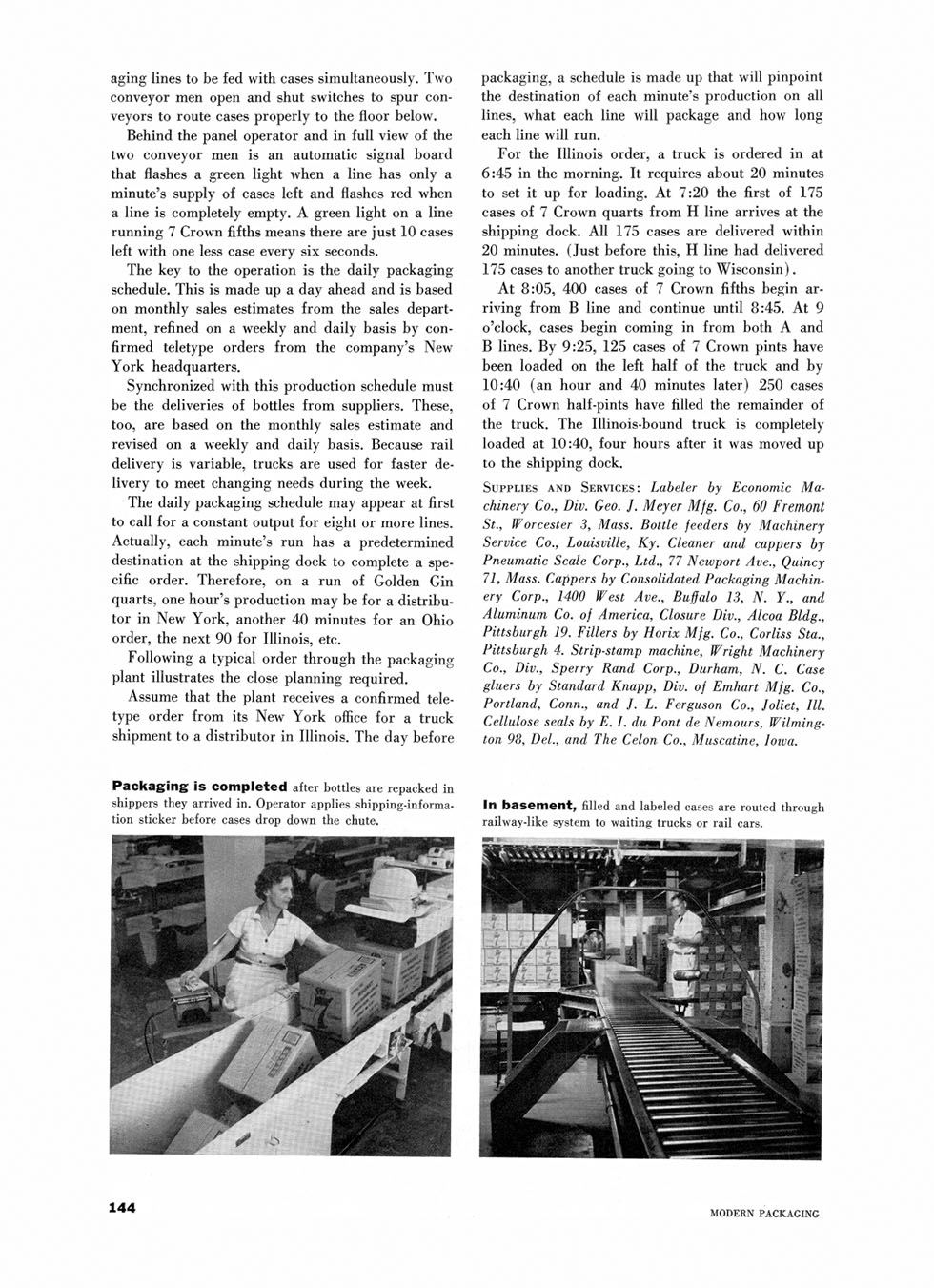


aging lines to be fed with cases simultaneously. Two conveyor men open and shut switches to spur conveyors to route cases properly to the floor below.
Behind the panel operator and in full view of the two conveyor men is an automatic signal board that flashes a green light when a line has only a minute's supply of cases left and flashes red when a line is completely empty. A green light on a line running 7 Crown fifths means there are just 10 cases left with one less case every six seconds.
The key to the operation is the daily packaging schedule. This is made up a day ahead and is based on monthly sales estimates from the sales department, refined on a weekly and daily basis by confirmed teletype orders from the company's New York headquarters.
Synchronized with this production schedule must be the deliveries of bottles from suppliers. These, too, are based on the monthly sales estimate and revised on a weekly and daily basis. Because rail delivery is variable, trucks are used for faster delivery to meet changing needs during the week.
The daily packaging schedule may appear at first to call for a constant output for eight or more lines. Actually, each minute's run has a predetermined destination at the shipping dock to complete a specific order. Therefore, on a run of Golden Gin quarts, one hour's production may be for a distributor in New York, another 40 minutes for an Ohio order, the next 90 for Illinois, etc.
Following a typical order through the packaging plant illustrates the close planning required.
Assume that the plant receives a confirmed teletype order from its New York office for a truck shipment to a distributor in Illinois. The day before
packaging, a schedule is made up that will pinpoint the destination of each minute's production on all lines, what each line will package and how long each line will run.
For the Illinois order, a truck is ordered in at 6:45 in the morning. It requires about 20 minutes to set it up for loading. At 7:20 the first of 175 cases of 7 Crown quarts from H line arrives at the shipping dock. All 175 cases are delivered within 20 minutes. (Just before this, H line had delivered 175 cases to another truck going to Wisconsin).
At 8:05, 400 cases of 7 Crown fifths begin arriving from B line and continue until 8:45. At 9 o'clock, cases begin coming in from both A and B lines. By 9:25, 125 cases of 7 Crown pints have been loaded on the left half of the truck and by 10:40 (an hour and 40 minutes later) 250 cases of 7 Crown half-pints have filled the remainder of the truck. The Illinois-bound truck is completely loaded at 10:40, four hours after it was moved up to the shipping dock.
Supplies and Services: Labeler by Economic Machinery Co., Div. Geo. J. Meyer Mfg. Co., 60 Fremont St., Worcester 3, Mass. Bottle feeders by Machinery Service Co., Louisville, Ky. Cleaner and cappers by Pneumatic Scale Corp., Ltd., 77 Newport Ave., Quincy 71, Mass. Cappers by Consolidated Packaging Machinery Corp., 1400 West Ave., Buffalo 13, N. Y., and Aluminum Co. of America, Closure Div., Alcoa Bldg., Pittsburgh 19. Fillers by Horix Mfg. Co., Corliss Sta., Pittsburgh 4. Strip-stamp machine, Wright Machinery Co., Div., Sperry Rand Corp., Durham, N. C. Case gluers by Standard Knapp, Div. of Emhart Mfg. Co., Portland, Conn., and J. L. Ferguson Co., Joliet, 111. Cellulose seals by E. 1. du Pont de Nemours, Wilmington 98, Del., and The Celon Co., Muscatine, Iowa.
Packaging is completed after bottles are repacked in shippers they arrived in. Operator applies shipping-information sticker before cases drop down the chute.
In basement, filled and labeled cases are routed through railway-like system to waiting trucks or rail cars.